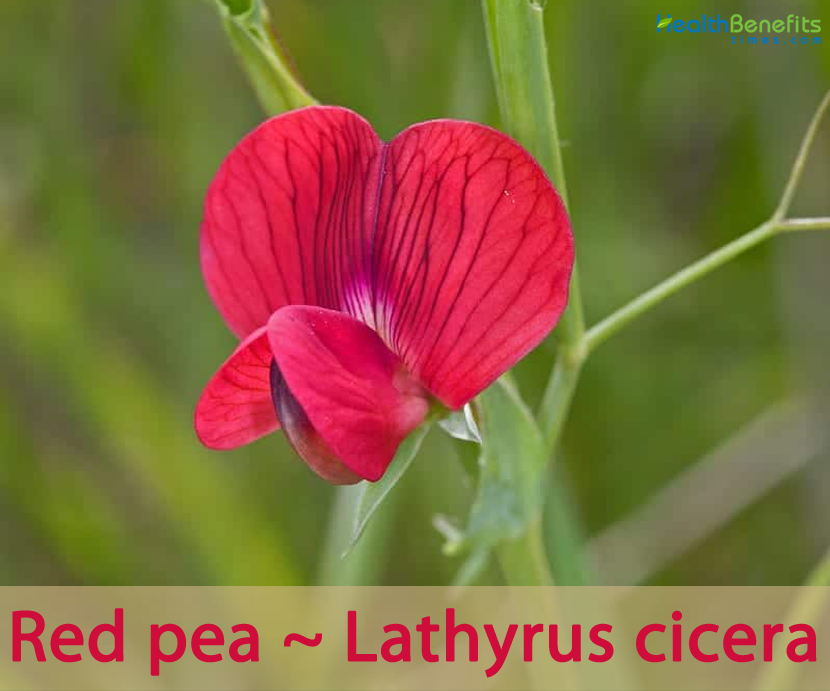| Red pea Quick Facts | |
|---|---|
| Name: | Red pea |
| Scientific Name: | Lathyrus cicera |
| Origin | Europe, North Africa, and the Middle East |
| Shapes | Hairless dehiscent legume pod |
| Taste | Astringent, Sweet, pungent |
Red Pea Facts
| Name | Red pea |
|---|---|
| Scientific Name | Lathyrus cicera |
| Native | Europe, North Africa, and the Middle East |
| Common Names | Flat-pod peavine, Flatpod peavine, Flat-podded vetchling, Dwarf chickling-vetch, Lesser chickpea, Red pea, Chickling-vetch, Red vetchling, Vetchling, wild vetch |
| Name in Other Languages | Albanian: Vingjra qiqër, vingjër Arabic: Djelbane Bou q’roun, jalban himsiun (جلبان حمصي) Bulgarian: Nakhutovo sekirche (нахутово секирче) Catalan: Guixó cigronenc, guixonera, guixó Chinese: Dui ye xiang wan dou, Xiang wan dou Croatian: Crvena kukavičica Czech: Hrachor cizrnový, hrachor cizrnovitý Danish: Foderfladbaelg, Murstensrød fladbælg Dutch: Kekerlathyrus English: Flat-pod peavine, Flatpod peavine, Flat-podded vetchling, Dwarf chickling-vetch, Lesser chickpea, Red pea, Chickling-vetch, Red vetchling, Vetchling, wild vetch Finnish: Etelännätkelmä French: Gesse chiche, Jarosse, gesse garosse, gesse pois-chiche, gessette, petite gesse German: Futterplatterbse, Platterbse, Kleine Platterbse, Rote Platterbse, Kicher-Platterbse, Kichererbsen-Platterbse Hindi: Khesari, Latri, Latree, Khesari, Kesari dal Hungarian: Csicseri borsó, csicserilednek Italian: Moco, Mochi, Cicerchia cicerchiella, cicherchia Maltese: Gilbiena tas-serp Netherlands: Lathyrus, keker Occitan: Garoulhe, garousse Portuguese: Chícharo-miudo, Cisirão-branco, araca, chícaros, chícharo-branco, chícharo-bravo, chícharos-miudos, cizirão, cizirão-branco, grão-da-gramicha Russian: China Nutovaya (чина нутовая) Serbian: Cастрица Slovak: Hrachor, hrachor cicerovitý Slovene: Cičkasti grahor Spanish: Galgana, Cicércula, Almorta de monte, Titarro, almorta Silvestre, cichercha, diente de muerto, galgarra, guija, guisa Silvestre, lenteja forrajera Swedish: Rödvial Turkish: Colban Ukrainian: China nutova (чина нутова) |
| Plant Growth Habit | Annual or perennial cool season climbing herb |
| Growing Climates | Fields and cultivated places |
| Plant Size | Up to 1 meter |
| Stem | Stems are prostrate, branching from near the base and often clinging to the surrounding vegetation by means of tendrils |
| Leaf | Leaves are each made up of two leaflike linear leaflets 3 to 6 centimeters (1.2 to 2.4 in) long. They also bear branched, curling tendrils |
| Flower | Inflorescence holds a single pea flower 1 to 1.5 centimeters (0.39 to 0.59 in) wide which is a varying shade of red. |
| Fruit Shape & Size | Fruit is a hairless dehiscent legume pod |
| Taste | Astringent, Sweet, pungent |
| Plant Parts Used | Seeds |
| Traditional Uses |
|
Plant Description
Red pea is an annual or perennial cool season climbing herb that normally grows up to 1 meter tall from a thin rootstock. The plant is found growing in fields and cultivated places. The stems are prostrate, branching from near the base and often clinging to the surrounding vegetation by means of tendrils. The leaves are each made up of two leaf like linear leaflets 3 to 6 centimeters (1.2 to 2.4 in) long. They also bear branched, curling tendrils. The inflorescence holds a single pea flower 1 to 1.5 centimeters (0.39 to 0.59 in) wide which is a varying shade of red. It blooms from spring to summer. Fertile flowers are followed by hairless dehiscent legume pod.
Culinary Uses
- Seedpods must be well cooked.
- Pea seeds are used as food in many dishes.
- In India, the seeds are dried, split and used to make dal.
- In Ethiopia, the seeds are finely ground to make a sauce.
- The sauce is supplemented with the Ethiopian traditional dish called Injera.
- In Nepal and Bangladesh, seeds are ground to make flour and used for flatbread or roti making.
Other Facts
- It is widely cultivated for human consumption and economic use.
- The seeds are used for human consumption and the fodder is for livestock feeding.
- The pea foliage and seeds are economically used as fodder.
- They can be used fresh, dried and as silage.
- The plant is used as a green manure and soil cover for preventing erosion and for rehabilitating degraded land.
Precautions
- The seed (and possibly the whole plant) is poisonous unless well cooked.
- The seed of some species in this genus contain a toxic amino acid that can cause a severe disease of the nervous system known as ‘lathyrism’ if they are eaten in large amounts (although small quantities are said to be nutritious).
- Excess and prolonged intake may cause paralysis below the knees in adults and brain damage in children.
- It is the cause of neurological disorders in the human body.
- Symptoms appear as a paralysis of the muscles below the knees, pains in the back, followed by weakness and stiffness of the legs and progressive locomotive incoordination.
References:
https://www.itis.gov/servlet/SingleRpt/SingleRpt?search_topic=TSN&search_value=25841#null
https://npgsweb.ars-grin.gov/gringlobal/taxon/taxonomydetail?id=21553
https://pfaf.org/user/Plant.aspx?LatinName=Lathyrus+cicera
http://www.theplantlist.org/tpl1.1/record/ild-7747
https://npgstest2.agron.iastate.edu/gringlobal/taxon/taxonomydetail?id=21553
https://en.wikipedia.org/wiki/Lathyrus_cicera
https://gd.eppo.int/taxon/LTHCI
https://www.cabi.org/isc/datasheet/31582
http://temperate.theferns.info/plant/Lathyrus+cicera
https://plants.usda.gov/home/plantProfile?symbol=LACI
Comments
comments
